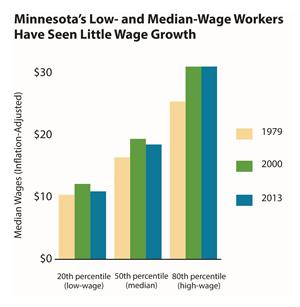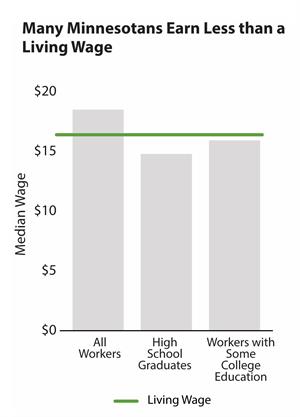Minnesota is known for our hard-working residents, but too many find that their hard work is not enough. Wages haven’t kept up with the cost of living, and jobs that only offer part-time hours and lack critical benefits aren’t enough to make ends meet.[1]
Even as the economic recovery has begun to take hold, too many Minnesotans still lack the quality jobs that would allow them to support themselves and their families.
- Low-wage workers have not regained lost wages from the recession.
- About one in six Minnesotans working part-time need full-time work to support their families.
- Two in five Minnesota workers lack basic benefits like earned sick leave.
- Minnesota’s economic success is not reaching all communities; people of color are more likely to be underemployed or unemployed.
Low-wage workers contribute billions of dollars to Minnesota’s economy each year, yet many workers still struggle to meet their basic needs like housing, transportation and child care. For our state to have a strong economy into the future, all Minnesotans need the opportunity to reach economic security. State policy choices have a role in building this kind of future, including policies that improve job quality, make education and training affordable, and help workers make ends meet and move into the middle class. For example, the recent law change to increase the state’s minimum wage will boost the incomes of about 325,000 Minnesota workers and their families after too many years of stagnant wages.
Wages Have Been Stagnant for Most Minnesotans
Minnesotans want to work and succeed. However, the benefits of Minnesota’s economic growth are not reaching all those who contribute to the state’s economic success.
The recession took its toll on wages. Low- and middle-wage workers are still behind where they were in 2000, adjusted for inflation. In fact, in 2013 low-wage workers were making about the same as they did in 1995 when inflation is taken into account, and median-wage workers’ wages were around 1999 levels.
Over a longer time span, high-wage workers have seen the fastest wage growth. High-wage workers’ wages grew by 22 percent from 1979 to 2013, while median-wage workers’ wages grew by 13 percent and low-wage workers’ wages only increased by 5 percent, after adjusting for inflation. This uneven wage growth has contributed to growing wage inequality in Minnesota. Hard work should pay off, but the benefits of economic growth haven’t been broadly shared.
Many Workers Can’t Afford The Basics

Stagnant wages mean that too many Minnesota workers are unable to afford a basic standard of living. The Minnesota Department of Employment and Economic Development calculates that a Minnesota family needs to earn $16.25 per hour to afford the basic needs for a two-parent family of three.[2] In 2013, half of all Minnesotans without a college degree made less than this wage. This living wage standard varies across the state, from $11.49 in Stevens County to $18.89 in Isanti County.
Minnesota’s low-wage workers are an important part of the state’s economy, earning a total of $6 billion in 2012.[3] They work at local grocery stores and take care of Minnesota’s children, and they spend their paychecks at local businesses. These workers are integral to our state economy, yet today too many of them cannot support their families.
People of Color Are More Likely to be Unemployed or Underemployed

Minnesota has a higher labor participation rate than the national average, defined as the percent of the state’s population age 16 and older in the workforce. And that’s true no matter how you look at it: Minnesotans of all races and ethnicities, genders, and education levels are working at higher rates than their counterparts nationally.
However, many Minnesotans, and disproportionately people of color, are unemployed or underemployed. [4] Unemployment is higher in communities of color. In 2013, while the overall unemployment rate was 4.9 percent, African-American Minnesotans were three times as likely to be unemployed as the state average, and unemployment among Hispanic and Asian Minnesotans was 6.9 and 5.8 percent respectively.
Almost 20 percent of part-time workers in Minnesota would prefer to work full-time, but the problem is much more prevalent among people of color. African-American part-time workers are twice as likely to want full-time work as the statewide average. Workers of color are also more likely to be underemployed, which is when a worker needs full-time employment or is not fully using their job skills. While overall 1 in 9 workers in Minnesota are underemployed, 1 in 6 Hispanic workers and nearly 1 in 3 African-American workers are underemployed.
With people of color making up an ever larger share of our workforce, it’s crucial for the state’s economic future that all Minnesotans have the opportunity to reach their fullest potential in the labor market.

Too Many Jobs Lack Basic Benefits
Earned sick leave and retirement benefits are critical components of job quality. Without the ability to earn paid leave, workers lose wages and may even lose their jobs when they take time off to care for themselves or a family member. Without retirement benefits, seniors struggle to make ends meet after working all their lives. Low-wage and part-time workers are more likely to have jobs that don’t offer these basic benefits.
Earned sick leave is important for the economic health of the state and its workers. Businesses that offer earned sick leave see lower turnover, and don’t experience significantly higher levels of absenteeism than those without paid leave.[5] Earned sick leave also ensures that when a mother takes time off to care for her sick child, she doesn’t need to worry about how she’ll pay the bills, or whether she’ll have a job to go back to.

About 1.1 million Minnesota workers don’t have any earned sick leave.[6] The problem is particularly common among part-time workers, three-quarters of whom don’t have any paid sick leave, and the lowest-wage workers, 66 percent of whom lack paid sick leave.[7] People of color also are more likely to have no earned sick days: In Minnesota, 60 percent of Hispanic workers and 47 percent of African-American workers do not have paid sick leave.
Additionally, many workers lack access to retirement benefits – an essential piece of planning for their futures. Nationally, nearly 1 in 3 workers don’t have any employer-provided retirement benefits.[8] And that number skyrockets to 63 percent when talking about part-time workers and to 59 percent for low-wage workers. There are many Minnesotans who are totally on their own when it comes to saving for retirement, especially those with the fewest resources to set aside for the future.
Policy Choices Can Expand Access to Good Jobs and Economic Security
Minnesota’s future economic success is threatened when so many workers can’t find good jobs. Lawmakers should adopt policies so that more Minnesotans can get and keep quality jobs to support themselves and their families. These include:
- Improving standards for job quality, such as the minimum wage and earned sick leave.
- Focusing on job quality and reaching communities with less access to economic opportunity in state economic development efforts.
- Investing in Minnesota’s workforce and ensuring all Minnesotans have access to affordable higher education and training.
- Helping low-wage workers make ends meet and move into the middle class, through work supports including child care assistance and affordable health care.
In the 2014 Legislative Session, Minnesota made important strides towards an economy where people who work hard can support their families. Policymakers raised the minimum wage, which will boost wages for 325,000 Minnesotans by $472 million.[9] This increase especially reaches those who struggle the most in our economy, including persons of color and women.
Policymakers also increased the Working Family Tax Credit by nearly 25 percent, which supports families working at low wages and ensures that these families aren’t paying more than their fair share to fund important public services.
The Women’s Economic Security Act passed in 2014 improved workplace protections so that workers can take care of sick family members, and supports employers to recruit and prepare women to enter non-traditional and high-wage jobs.
Additionally, the very low-income parents who participate in the Minnesota Family Investment Program will be able to access the education and training they need to compete for good jobs. Policymakers also improved Adult Basic Education by removing limits on English language instruction so that new Minnesotans are better prepared for the workforce.
These recent steps represent a positive focus on improving job quality and supporting low-income Minnesotans in climbing ladders into the middle class. Policymakers should continue this momentum in 2015 through policy changes including:
- Making affordable child care available to more Minnesota families. Child care can be one of the largest expenses that families with young children face. In addition, having reliable, affordable child care that fits a family’s needs is essential for parents to succeed in the workplace. Currently 6,200 Minnesota families are on waiting lists for child care assistance.[10] An increase in funding for Basic Sliding Fee child care assistance and expanding the state’s Child and Dependent Care Tax Credit for low- and moderate-income families are two important steps toward all Minnesota families being able to afford child care.
- Expanding earned sick leave. Over one million Minnesotans face the predicament of losing wages or even their jobs if they take time to care for themselves or a loved one. Making earned sick leave available to more workers would help families meet their basic needs, reduce employee turnover, and contribute to healthier and more productive workplaces.
Our state needs a strong workforce to build a vibrant economy. But too many Minnesotans are being left out and left behind, especially low-wage workers, women and people of color. Further policy steps should be taken to increase opportunities for all Minnesotans to find and keep good jobs, and build an economy that works for all Minnesotans.
By Clark Biegler
[1] Except where otherwise noted, data in this report come from analysis by the Economic Policy Institute of Current Population Survey and Bureau of Labor Statistics data. All median wage calculations are inflation adjusted to 2013.
[2] Minnesota Department of Employment and Economic Development, Cost of Living in Minnesota, 2014.
[3] Minnesota Budget Project analysis of American Community Survey Data 1-year estimates, 2012.
[4] This analysis only looks at persons of color in African-American and Hispanic populations because of data availability. However, other data indicates that other communities of color in Minnesota also face higher unemployment than white Minnesotans.
[5] National Partnership for Women and Families, Paid Sick Days: Good for Business, Good for Workers, August 2012, and National Partnership for Women and Families, Busting the Myths about Paid Sick Days, December 2010.
[6] Institute for Women’s Policy Research, Access to Paid Sick Days in Minnesota, September 2014.
[7] This figure applies to workers earning $15,000 or less.
[8] U.S. Bureau of Labor Statistics, Employee Benefits in the United States, March 2014.
[9] JOBS NOW Coalition, A Raise for Minnesota, 2013.
[10] Minnesota Department of Human Services, Child Care Assistance Program: Number of Families on the Basic Sliding Fee Waiting List, November 2014.